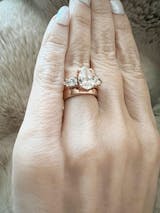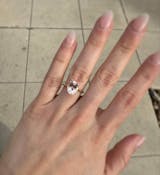Diamonds might get all the attention, but they’re not the only white gemstones worth swooning over! If you're looking for a dazzling alternative to diamonds, white sapphire and moissanite are two incredible contenders. Both gems boast beauty, durability, and affordability - but which one is right for you? Let’s break down the differences so you can find your perfect match!
What Is White Sapphire?
White sapphires belong to the corundum mineral family - the same group as rubies and blue sapphires. Their colorless nature comes from a lack of trace elements like magnesium, chromium, titanium, copper, and iron. White sapphires are naturally stunning and have been a sought-after choice for engagement rings and other fine jewelry pieces for centuries.

White Sapphire Ultra Petite Kelsey
What Is Moissanite?
Moissanite has an out-of-this-world origin…literally! A moissanite is a rare, naturally occurring mineral that’s also known as silicon carbide. They are so rare that all of the gems are lab grown. Why is that? Moissanites come from the stars! They only crystallize when a meteor hits the earth. How crazy is that?! With its high clarity, durability and incredible sparkle, moissanite has skyrocketed in popularity as an alternative to diamonds in engagement rings. 10x7mm Phoebe Moissanite Engagement Ring
10x7mm Phoebe Moissanite Engagement Ring
What’s The Difference Between White Sapphire And Moissanite?
Both gemstones are clear, durable, and budget-friendly, but they each have unique qualities that set them apart. So what's the difference?
Hardness & Durability
When it comes to everyday wear, both gems hold up beautifully and you can’t go wrong with either option. On the Mohs scale:
-
White sapphire ranks 9.0 (very hard but can show wear over time, especially the edges).
-
Moissanite ranks 9.5 (even tougher and a bit more resistant to scratches).
Appearance & Sparkle
Both stones appear colorless, but there are some key differences:
-
White sapphires have a soft, subtle glow. They may develop surface scratches over time and require more frequent cleaning to maintain their brilliance.
-
Moissanite is known for its intense sparkle. It has a higher refractive index (2.65-2.69 compared to sapphire’s 1.77) and fire (0.104 compared to sapphire’s 0.018). Some people have noted that moissanite’s fire can be too much- resulting in a rainbow/disco ball flash.
Price
Both gems offer a more budget-friendly option compared to diamonds, but pricing varies:
-
White sapphire is usually the more affordable choice, especially in sizes under 1.50 carats. As the natural sapphire gets larger in size, the price per carat starts to add up due to rarity
-
Moissanite tends to cost slightly more due to its superior brilliance and lab-created nature.
If you’re looking for the most cost-effective option, white sapphire takes the crown. But if you’re after the biggest bang for your buck in terms of sparkle, moissanite is a fantastic investment.
Which Gemstone Should You Choose?
There’s no wrong answer—it all comes down to what matters most to you!
-
Choose white sapphire if you love a natural gemstone with a soft, subtle glow and a more budget-friendly price.
-
Choose moissanite if you want ultra-bright brilliance, incredible durability, and a gemstone that mimics a diamond’s fire.
No matter which stone you pick, both make stunning alternatives to traditional diamonds, and both will shine beautifully in your engagement ring or fine jewelry piece! As always, be sure to follow us on our socials, check out our website and subscribe to our newsletter to see what’s new here at Love & Promise. Catch you next time, friends!




































